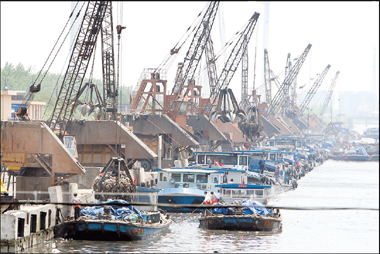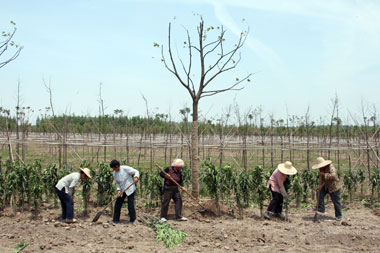|
|


ADVERTISEMENT
Buy Your own advertising
spaces!
.
Download Adobe Acrobat Reader to open [PDF] files.
Recent Visitors
Get a whiff of this - Landfill is coming up roses
2009. 2 June
(shanghaidaily.com) Every day, Shanghai generates a vast amount of solid waste - from orange peels to industrial garbage - and the expected 70 million visitors to the six-month World Expo 2010 will generate even more. by Pan Zheng
by Pan Zheng
Seventy percent of the city's waste, 7,000-9,000 tons a day, is handled by one facility and landfill, the 410-hectare Laogang Waste Disposal Center in Nanhui, Pudong New Area.
The entire city of 19 million residents generates 12,000-16,000 tons of waste daily. Over the years, Laogang has handled an estimated two tons per resident.
The parklike Laogang, which still has a bit of an aroma, is going greener, planting a forest and getting ready to handle the garbage from the Expo site as well.
 It's smelling better, though not quite like roses yet.
It's smelling better, though not quite like roses yet.
The vast landfill, which employes around 500 workers, is located on the East Sea. Because of the huge amount of waste, it has been expanding into the sea - building dams and retaining walls every few years and sealing the garbage so that the ocean isn't polluted.
This could go on for quite some time and a container terminal/dock will be operational this summer, receiving sealed garbage by barge from around the city.
"Often our workers have to work overtime, usually for two hours, until we finish our daily task," says Zhao Jin, Party secretary of Laogang Disposal Co Ltd.
The facility, started in late 1985 as a public institution, is now state-run.
Today it seems like a park and top priority is placed on protecting the environment and ensuring that many nearby residents are not offended by the look and the smell, or injured by pollution.
After it opened, environmental pollution was a serious problem.
The smell was powerful, nearby rivers and streams were severely polluted and many employees worried about their health.
"My biggest concern after retirement is a healthy body, but who knows?" said an employee. These days, however, the situation has improved.
Since 2004, when Laogang became a state-run enterprise, environmental protection has improved greatly.
"We have undertaken a series of measures to control the smell, such as using deodorizers and covers," says general manager Yan Guangliang. "But the most effective method is to expand our green area."
Green is the dominant color these days.
"Plants can absorb some of the bad odor and refresh the air. So for us, the more green area the better," says Zhao, the Party secretary.
Still, smell is a problem.
Before Spring Festival this year, a major forestation project began, expanding the green area with trees. The cost is around 230 million yuan (US$33.6 million), including compensation to residents who must relocate.
The forest on the west side of Laogang will occupy 104 hectares, 3.6 kilometers long and 200-270 meters wide. Planting will be completed this summer.
"The varieties of the trees and other plants of this forest have been carefully selected by our engineers to maximize their protective effect," says Zhao. "With this forest, the surrounding environment will be greatly improved."
Besides the special attention attached to the environmental protection, Laogang is also cashing in on new recycling technologies. Recently, it achieved great progress in the experiment of making briquette from mud to save energy.
"The briquette is now useful, but there's still some smell when it's burning. How to reduce the smell is our next step in the experiment," says Zhou Haiyan, chief engineer of Laogang.
Laogang is also improving disposal capacity and this summer it opens the Laogang Container Terminal, with an annual capacity to receive 3.7 million sealed containers. Another urban terminal for solid waste transport will send waste to Laogang.
"This is a great reform in garbage disposal, not only for Laogang but for the entire city of Shanghai," says General Manager Yan.
Every day, Shanghai generates a vast amount of solid waste - from orange peels to industrial garbage - and the expected 70 million visitors to the six-month World Expo 2010 will generate even more.
Seventy percent of the city's waste, 7,000-9,000 tons a day, is handled by one facility and landfill, the 410-hectare Laogang Waste Disposal Center in Nanhui, Pudong New Area.
The entire city of 19 million residents generates 12,000-16,000 tons of waste daily. Over the years, Laogang has handled an estimated two tons per resident.
The parklike Laogang, which still has a bit of an aroma, is going greener, planting a forest and getting ready to handle the garbage from the Expo site as well.
It's smelling better, though not quite like roses yet.
The vast landfill, which employes around 500 workers, is located on the East Sea. Because of the huge amount of waste, it has been expanding into the sea - building dams and retaining walls every few years and sealing the garbage so that the ocean isn't polluted.
This could go on for quite some time and a container terminal/dock will be operational this summer, receiving sealed garbage by barge from around the city.
"Often our workers have to work overtime, usually for two hours, until we finish our daily task," says Zhao Jin, Party secretary of Laogang Disposal Co Ltd.
The facility, started in late 1985 as a public institution, is now state-run.
Today it seems like a park and top priority is placed on protecting the environment and ensuring that many nearby residents are not offended by the look and the smell, or injured by pollution.
After it opened, environmental pollution was a serious problem.
The smell was powerful, nearby rivers and streams were severely polluted and many employees worried about their health.
"My biggest concern after retirement is a healthy body, but who knows?" said an employee. These days, however, the situation has improved.
Since 2004, when Laogang became a state-run enterprise, environmental protection has improved greatly.
"We have undertaken a series of measures to control the smell, such as using deodorizers and covers," says general manager Yan Guangliang. "But the most effective method is to expand our green area."
Green is the dominant color these days.
"Plants can absorb some of the bad odor and refresh the air. So for us, the more green area the better," says Zhao, the Party secretary.
Still, smell is a problem.
Before Spring Festival this year, a major forestation project began, expanding the green area with trees. The cost is around 230 million yuan (US$33.6 million), including compensation to residents who must relocate.
The forest on the west side of Laogang will occupy 104 hectares, 3.6 kilometers long and 200-270 meters wide. Planting will be completed this summer.
"The varieties of the trees and other plants of this forest have been carefully selected by our engineers to maximize their protective effect," says Zhao. "With this forest, the surrounding environment will be greatly improved."
Besides the special attention attached to the environmental protection, Laogang is also cashing in on new recycling technologies. Recently, it achieved great progress in the experiment of making briquette from mud to save energy.
"The briquette is now useful, but there's still some smell when it's burning. How to reduce the smell is our next step in the experiment," says Zhou Haiyan, chief engineer of Laogang.
Laogang is also improving disposal capacity and this summer it opens the Laogang Container Terminal, with an annual capacity to receive 3.7 million sealed containers. Another urban terminal for solid waste transport will send waste to Laogang.
"This is a great reform in garbage disposal, not only for Laogang but for the entire city of Shanghai," says General Manager Yan.


